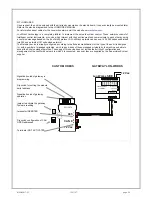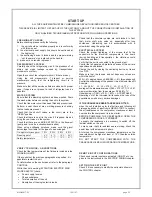
M03I40M7-03 15/11/07
page
38
MAINTENANCE INSPECTIONS
Foresee inspection assistance carried out by authorized
centers or by qualified personnel.
The inspections should be carried out at least:
•
- Every year for only the cooling units
•
- Every six months for the cooling and warming
units
The frequency, however, depends on the use: in the event
of frequent use (continuous or very intermittent use, near
the operating limits, etc) or critical use (service necessary)
it is recommended to plan inspections at close intervals.
The inspections to be performed are as follows:
•
verify the power supply tension (when emptied or filled)
•
inspect the electrical board (status of solenoid starter
contacts, terminal closings, the status of wiring and
relevant insulations)
•
inspect the absorption of the single electrical loads
•
verify the cleaning and the efficiency of the exchangers
•
inspect the cleaning of the filters (air/water)
•
verify the leakage from the refrigerating circuit
•
Verify the protection devices (safety valves, pressure
switches, thermostats, etc.), the adjustment systems,
the control devices (alarm signalizations, probes,
manometers, etc)
•
check the operating parameters of the refrigerating
circuit (see the following REFRIGERANT TABLES and
the START-UP section)
For units equipped with safety valves, follow the
Manufacturer’s instructions.
Verify periodically the cleaning of the safety valves and
that oxidative / corrosive phenomena are not present, in
particular for installations near the sea, in industrial areas
or in rooms with a corrosive atmosphere.
97/23 CE PED DIRECTIVE
97/23 CE PED DIRECTIVE gives instructions for installers,
users and maintenance technicians as well. Refer to local
actuation norms.
In Italy, refer to the Ministerial Decree of 1
st
December
2004 no. 329 (and following modifications) which defines
the performances to be executed; the units of
1
st
category
and those defined by the art. 3.3 97/23/EC are not
included in this regulation (see the serial number plate on
the unit) .
Briefly and as an example, see the following :
1. COMPULSORY VERIFICATION OF THE FIRST
INSTALLATION only for units assembled on the
installer’s building site (for ex. Condensing c
direct expansion unit)
2. CERTIFICATION OF SETTING IN SERVICE for all
the units
3. PERIODICAL VERIFICATIONS to be executed with
the frequency indicated by the Manufacturer (see the
MAINTENANCE INSPECTIONS paragraph)
PUT AT REST
If a long period of inactivity is foreseen, for example the
winter for the cooling unit, the following is recommended:
•
to turn the power off in order to avoid electrical risks or
damages by lightning strike
•
to avoid the risk of frosts as shown in the HYDRAULIC
CONNECTIONS section, and, in particular
- to empty or add glycole in the plant sections
subjected to temperatures below zero
- to empty or add glycole in the water heating coils,
also in summer
- to power antifreeze resistances if present
If the period of inactivity is particularly long or in the event
of extremely low temperatures, the external fans can be
blocked temporarily; therefore, it is recommended to switch
them on every month in order to avoid seizures or
electrical overloads when the unit will be switched on.
The restarting of the unit has to be carried out by qualified
personnel, in particular, after the winter break for cooling
units or when seasonal switching should be performed.
When restarting, refer to the SWITCHING ON section.
Schedule technical assistance in advance to avoid hitches
and be able to use the installation when necessary.
















































